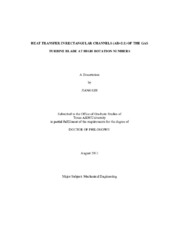| dc.description.abstract | Gas turbine blade/vane cooling is obtained by circulating the high pressure air from compressor to the internal cooling passage of the blade/vane. Heat transfer and cooling effect in the rotating blade is highly affected by rotation. The typical rotation number for the aircraft engine is in the range of 0~0.25 and for the land based power generation turbine in the range of 0~05. Currently, the heat transfer data at high rotation numbers are limited. Besides, the investigation of heat transfer phenomena in the turn region, especially near hub portion is rare. This dissertation is to study the heat transfer in rectangular channels with turns in the tip or the hub portion respectively at high rotation numbers close to the engine condition.
The dissertation experimentally investigates the heat transfer phenomena in a two-pass rectangular channel (AR=W/H=2:1) with a 180 degree sharp turn in the tip portion. The flow in the first passage is radial outward and after the turn in the second passage, the flow direction is radial inward. The hydraulic diameter (Dh) of the channel is 16.9 mm. Parallel square ribs with an attack angle (alpha) of 45 degrees are used on leading and trailing surfaces to enhance the heat transfer. The rib height-to-hydraulic diameter ratio (e/Dh) is 0.094. For the baseline smooth case and the case with rib pitch-to-height ratio (P/e) 10, channel orientation angles (beta) of 90 degrees and 135 degrees were tried to model the cooling passage in the mid and rear portion of the blade respectively. Two other P/e ratios of 5 and 7.5 were studied at beta=135 degrees to investigate their effect on heat transfer. The data are presented under high rotation numbers and buoyancy parameters by varying the Reynolds number (Re=10,000~40,000) and rotation speed (rpm=0~400). Corresponding rotation number and buoyancy parameter are ranged as 0~0.45 and 0~0.8 respectively.
The dissertation also studies the heat transfer in a two-pass channel (AR=2:1) connected by a 180 degree U bend in the hub portion. The flow in the first passage is radial inward and after the U bend, the flow in the second passage is radial outward. The cross-section dimension of this channel is the same as the previous one. To increase heat transfer, staggered square ribs (e/Dh=0.094) are pasted on leading and trailing walls with an attack angle (alpha) of 45 degrees and pitch-to-height ratio (P/e) of 8. A turning vane in the shape of half circle (R=18.5 mm, t=1.6 mm) is used in the turn region to guide the flow for both smooth and ribbed cases. Channel orientation angles (beta) of 90 degrees and 135 degrees were taken for both smooth and ribbed cases. The heat transfer data were taken at high rotation numbers close to previous test section. | en |


